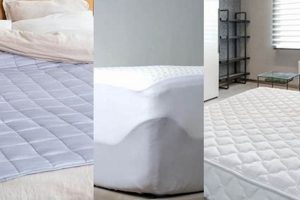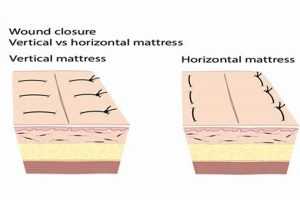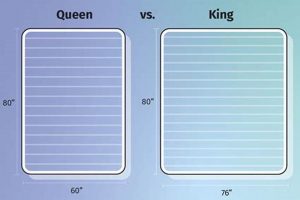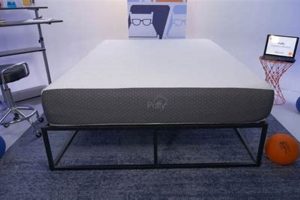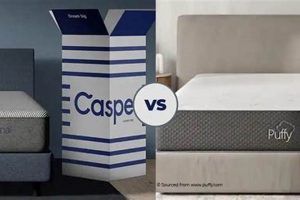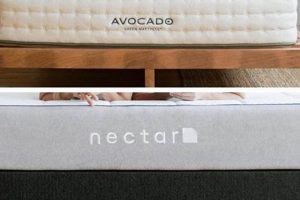The central comparison involves two distinct approaches to infant and toddler sleep surfaces. One option focuses on certified organic materials, prioritizing natural components and minimizing exposure to synthetic chemicals. The alternative emphasizes breathability and washability, employing a polymer structure designed to enhance airflow and simplify cleaning.
Selecting a safe and comfortable sleep environment for infants is paramount for parental peace of mind and child well-being. The former ensures reduced risk of exposure to potentially harmful substances and allergens, aligning with a holistic approach to health. The latter offers convenience and addresses concerns related to hygiene and potential suffocation hazards, providing a different form of assurance.
The following sections will delve into specific material compositions, construction methods, safety certifications, and performance characteristics of each mattress type, enabling a thorough evaluation to aid in informed decision-making regarding optimal sleep solutions for young children.
Considerations for Selecting a Crib Mattress
The selection of a crib mattress requires careful evaluation of multiple factors. Prioritize safety standards, material composition, and performance characteristics to ensure an appropriate sleep environment for the infant.
Tip 1: Assess Certification Standards: Verify compliance with established safety certifications such as GOTS (Global Organic Textile Standard) for organic materials and GREENGUARD Gold for low chemical emissions. Certification provides an independent verification of material safety and product performance.
Tip 2: Evaluate Material Composition: Examine the components of the mattress, including the cover, core, and any adhesives used. Opt for materials known for low toxicity and hypoallergenic properties, such as organic cotton, wool, or food-grade polyethylene.
Tip 3: Consider Breathability: A breathable mattress can contribute to improved airflow and reduced risk of overheating. Mattresses with enhanced airflow design may be advantageous, particularly for infants with sensitivities to temperature changes.
Tip 4: Assess Cleanability and Hygiene: Infant mattresses are prone to accidents. Evaluate the ease of cleaning and the ability to prevent bacterial growth. Removable, washable covers and waterproof layers can facilitate hygiene maintenance.
Tip 5: Examine Firmness: A firm mattress is crucial for infant safety. Ensure the mattress meets recommended firmness standards to reduce the risk of suffocation. The mattress should not conform significantly to the infant’s body.
Tip 6: Weight and Handling: Consider the mattress weight for ease of changing sheets and cleaning. A lighter mattress may be more convenient for routine maintenance tasks.
Tip 7: Longevity and Warranty: Review the product warranty and expected lifespan of the mattress. A longer warranty can indicate greater confidence in the product’s durability and performance.
Careful consideration of these factors contributes to a more informed decision regarding crib mattress selection. Each aspect plays a role in ensuring infant safety, comfort, and overall well-being.
The following sections will offer a concluding summary of the key differences and benefits of each mattress type.
1. Organic Certification
Organic certification serves as a verifiable assurance of material purity and environmental stewardship within the context of infant mattresses. The presence or absence of such certification differentiates product offerings significantly. When evaluating mattress options, organic certification impacts both the production process and the final composition of the product. Specifically, Naturepedic prioritizes organic materials, securing certifications, such as GOTS, that attest to the organic sourcing and processing of its components. This approach aims to reduce exposure to synthetic chemicals and potentially allergenic substances. The absence of organic certification necessitates closer scrutiny of the non-certified product’s materials and manufacturing processes. The impact on the mattress consumer is, therefore, in the degree to which the manufacturing claims are transparent and independently verifiable, offering parents trust and assurance of the material safety of the sleep surface for their children.
Newton’s primary focus diverges from complete organic sourcing, emphasizing breathability and washability, which are achieved with food-grade polymer materials. Although not certified as organic, the materials are low VOC and GREENGUARD Gold certified, indicating the minimization of off-gassing and chemical emissions. The practical significance of understanding these distinctions lies in enabling consumers to align their purchasing decisions with their individual priorities and risk assessments. Parents seeking maximum avoidance of synthetic materials may favor certified organic options, while those prioritizing breathability and ease of cleaning might find the alternative more suitable, even if its composition is not entirely organic.
In summary, organic certification represents a key differentiator impacting the materiality of the crib mattress. While it holds substantial weight for consumers prioritizing organic material sourcing and minimal chemical exposure, the absence of such certification does not inherently equate to a hazardous product. Thorough assessment of all material components, safety certifications obtained, and manufacturing processes, along with individual priorities, is necessary for informed decision-making.
2. Breathability Comparison
The breathability of a crib mattress influences airflow and temperature regulation during infant sleep. The nature of mattress construction directly impacts this attribute, representing a key differentiating factor when assessing models. In the context of the central comparison, significant variations in breathability exist between the options.
One design incorporates a woven polymer core engineered to maximize airflow. This structure facilitates the dissipation of heat and moisture, potentially reducing the risk of overheating and promoting a more consistent sleep environment. In contrast, the alternative, utilizing organic materials like cotton and wool, exhibits a different breathability profile. While these materials possess inherent absorbent properties, their density and layered construction may limit airflow compared to the open-weave polymer design. Actual tests comparing mattresses confirm these expectations. Cases show enhanced temperature regulation and minimized moisture retention when using the highly-breathable mattress, thus promoting more comfortable sleep, particularly in warmer environments. This offers a distinct advantage for infants susceptible to overheating.
Therefore, consideration of breathability becomes paramount when selecting a crib mattress, particularly for infants with specific needs or those residing in warmer climates. Understanding the structural and material properties governing airflow enables informed decisions tailored to individual circumstances. The measurable differences in breathability, coupled with the understanding of the thermal regulation process, should thus guide parents as they choose between different models. By prioritizing an appropriate level of breathability, the likelihood of maintaining a safe and comfortable sleep environment for the infant is significantly enhanced.
3. Material Composition
The core distinction between the mattress options lies in their respective material compositions. These differences directly influence safety characteristics, comfort levels, and overall suitability for infant use. One mattress emphasizes certified organic materials, primarily organic cotton and wool, aiming to minimize exposure to synthetic chemicals and potential allergens. This approach aligns with a preference for natural components, promoting a potentially healthier sleep environment. Conversely, the alternative mattress utilizes a food-grade polymer material for its core, prioritizing breathability and washability. This synthetic composition allows for an open structure that facilitates airflow and enables easy cleaning, addressing concerns regarding hygiene and potential suffocation risks. The choice between these material approaches is not solely aesthetic; the structural integrity and safety profile of each material are important factors for the end-user.
For example, the use of organic cotton in one mattress option necessitates verification through certifications, like GOTS. This certification guarantees the cotton is grown without synthetic pesticides or fertilizers, reducing potential chemical exposure for the infant. The practical effect of this choice is reduced exposure to potentially harmful chemicals, aligning with a holistic health approach. In contrast, the polymer material, while not organic, undergoes rigorous testing to ensure it is free from harmful chemicals, such as phthalates, lead, and VOCs. This testing is often validated through certifications like GREENGUARD Gold, demonstrating a commitment to low chemical emissions and indoor air quality. The significance of this material choice is providing a practical solution to cleanability, ensuring that the infant’s sleep surface remains hygienic and reducing the risk of bacterial growth.
In conclusion, the choice in material composition represents a fundamental divergence in design philosophy. The organic approach prioritizes natural materials and reduced chemical exposure. The synthetic approach prioritizes breathability and ease of cleaning. There are no universally correct choices, thus comprehensive evaluation of safety certifications, material properties, and individual priorities is essential. Understanding the implications of each material choice allows for informed decision-making, optimizing infant safety and comfort based on individual needs and preferences.
4. Cleanability Features
Cleanability constitutes a critical attribute in infant mattress selection, directly influencing hygiene maintenance and allergen control. The ease with which a mattress can be cleaned impacts the health and safety of the infant, particularly in managing spills, accidents, and potential microbial growth. Significant differences exist in the cleanability features offered by various mattress designs.
- Removable and Washable Covers
Mattress covers that are easily removable and machine-washable provide a practical means of addressing spills and stains promptly. This feature allows for regular cleaning, mitigating the accumulation of allergens and bacteria. For instance, a cover that can be unzipped and laundered significantly simplifies the process compared to spot-cleaning an integrated cover. In the comparison of mattresses, this feature can greatly contribute to hygiene maintenance.
- Waterproof Layers
The presence of a waterproof layer protects the mattress core from liquid penetration, preventing the growth of mold and mildew. This layer acts as a barrier against spills and accidents, safeguarding the mattress integrity and prolonging its lifespan. A waterproof barrier, typically composed of a non-toxic material, simplifies cleaning by containing spills on the surface, reducing the need for extensive cleaning or core replacement, offering parental reassurance.
- Washable Core Construction
Certain mattress designs incorporate a core structure that can be directly washed, providing a more thorough cleaning option. This feature addresses concerns about internal contamination and allows for the removal of accumulated dirt and allergens. A washable core promotes enhanced hygiene.
- Material Resistance to Stains and Odors
The materials used in mattress construction exhibit varying degrees of resistance to stains and odors. Materials that are inherently resistant to microbial growth and odor retention contribute to a cleaner and fresher sleep environment. The use of antimicrobial-treated fabrics or naturally resistant materials reduces the likelihood of persistent stains and odors, which is a distinct advantage for maintaining a hygienic sleep surface over time.
The cleanability features integrated into a crib mattress directly influence its hygiene maintenance and contribute significantly to a healthier sleep environment. When comparing mattress options, evaluating the presence and effectiveness of these features is essential for making an informed decision that aligns with individual needs and priorities. Selecting a mattress with robust cleanability features allows for easier maintenance and contributes to long-term infant health and safety.
5. Firmness Standards
Crib mattress firmness is a primary safety consideration, influencing infant sleep safety and development. Current standards aim to mitigate the risk of Sudden Infant Death Syndrome (SIDS) and suffocation. Evaluating the compliance of different mattress types with these standards is critical when comparing options.
- Government Regulations and Guidelines
Regulatory bodies, such as the Consumer Product Safety Commission (CPSC), establish mandatory safety standards for crib mattresses. These standards dictate minimum firmness requirements to prevent infants from sinking into the mattress, reducing the risk of airway obstruction. Strict adherence to these guidelines is expected of all manufacturers, including those producing organic or breathable mattresses. Any mattress failing to meet these requirements poses a significant safety hazard.
- Testing Protocols for Firmness
Specific testing protocols are employed to assess mattress firmness. These tests often involve measuring the degree of indentation under specific weight loads. Mattresses undergoing these tests must meet defined criteria to be deemed compliant. These testing procedures help to ensure consistent and objective measurement of firmness across different mattress brands and materials, allowing for accurate comparisons.
- Impact of Materials on Firmness
The materials used in a crib mattress directly impact its firmness. Denser materials, such as compressed cotton or firm latex, typically result in a firmer sleep surface. In contrast, softer materials may compromise firmness. The design and layering of materials are crucial in achieving the required firmness level while maintaining comfort. Manufacturers often combine different materials to optimize both firmness and comfort.
- Long-Term Firmness Maintenance
Maintaining firmness over time is essential for continued safety. Repeated use and compression can cause some mattresses to soften, compromising their ability to meet safety standards. Mattresses should be constructed with durable materials designed to resist degradation and maintain their original firmness level. Evaluating the expected lifespan and warranty terms can provide insights into the long-term firmness performance of a crib mattress.
When comparing mattress options, assessing their compliance with firmness standards is of utmost importance. The material composition, construction methods, and testing protocols employed by each manufacturer should be carefully evaluated to ensure the chosen mattress meets the required safety criteria and maintains its firmness over time, guaranteeing a safe sleep environment for the infant. Understanding the degree to which each mattress option complies with these well-defined firmness standards allows parents to make an informed choice that aligns with the safety guidelines established by regulatory bodies.
6. Safety Compliance
Safety compliance, encompassing adherence to established standards and regulations, constitutes a foundational component when evaluating infant mattresses. For two distinct products in this category, rigorous assessment of safety features is paramount. Compliance dictates material selection, design parameters, and manufacturing processes, directly impacting infant well-being. Failure to adhere to these standards can lead to potential hazards, undermining the purpose of the sleep environment. For example, regulations pertaining to flammability, chemical emissions, and structural integrity serve as benchmarks against which products must be tested and validated.
The application of safety standards manifests differently depending on the construction and materials. In one product, compliance involves demonstrating adherence to organic certification requirements and minimizing exposure to potentially harmful substances. Stringent testing protocols ensure the absence of prohibited chemicals and the integrity of organic materials. In contrast, the alternative focuses on compliance through structural design features promoting breathability and reducing suffocation risks. This necessitates adherence to regulations governing airflow and the absence of small parts that could pose choking hazards. Practical examples include passing flammability tests according to 16 CFR Part 1633 and achieving GREENGUARD Gold certification for low chemical emissions.
Ultimately, safety compliance acts as a unifying principle, guiding the development and evaluation of infant mattresses. While distinct in their construction and material choices, both types must demonstrate unwavering commitment to meeting or exceeding safety regulations. This commitment translates into tangible benefits for infants, providing a secure and healthy sleep environment. Understanding the nuances of safety compliance and how it is achieved by each product allows caregivers to make informed decisions, prioritizing infant safety and well-being above all else.
Frequently Asked Questions
The following section addresses common inquiries regarding infant mattress selection, focusing on key considerations relevant to ensuring safety and optimal sleep environment for infants.
Question 1: What are the primary differences between certified organic and breathable polymer mattresses?
Certified organic mattresses prioritize natural materials, such as organic cotton and wool, minimizing exposure to synthetic chemicals. Breathable polymer mattresses emphasize airflow and cleanability, utilizing food-grade polymer materials for enhanced ventilation and ease of washing.
Question 2: Why is mattress firmness a critical safety factor for infants?
Firmness prevents infants from sinking into the mattress, reducing the risk of airway obstruction and suffocation. A firm surface ensures the infant remains on their back and minimizes the potential for positional asphyxia.
Question 3: How does organic certification contribute to infant safety?
Organic certification verifies that the materials used in the mattress are grown without synthetic pesticides, herbicides, or fertilizers. This minimizes the infant’s exposure to potentially harmful chemicals and allergens, promoting a healthier sleep environment.
Question 4: What are the advantages of a breathable mattress for infants?
Breathable mattresses promote airflow, facilitating temperature regulation and reducing the risk of overheating. Enhanced ventilation minimizes moisture retention, creating a more comfortable and hygienic sleep surface.
Question 5: How can parents ensure a crib mattress meets established safety standards?
Parents should verify that the mattress complies with certifications such as GOTS (Global Organic Textile Standard) for organic materials and GREENGUARD Gold for low chemical emissions. Compliance with CPSC (Consumer Product Safety Commission) standards is also essential.
Question 6: What cleaning practices are recommended for maintaining infant mattress hygiene?
Regularly cleaning the mattress cover by following the manufacturer’s instructions is recommended. Utilizing a waterproof mattress protector can prevent liquid penetration and simplify cleaning. Periodically airing out the mattress can also contribute to maintaining freshness.
In summary, selecting an appropriate infant mattress necessitates evaluating material composition, safety certifications, firmness standards, and cleanability features. These factors collectively contribute to ensuring a safe, healthy, and comfortable sleep environment for infants.
The subsequent section will provide a concluding summary highlighting the essential considerations for informed mattress selection.
Naturepedic vs Newton Mattress
The preceding analysis has illuminated the critical distinctions between Naturepedic and Newton mattresses, focusing on material composition, breathability, firmness, safety compliance, and cleanability. Naturepedic prioritizes certified organic materials to minimize chemical exposure, while Newton emphasizes breathability and washability through its polymer construction. The appropriate selection hinges on individual priorities, risk assessments, and specific infant needs. Thorough evaluation of certifications, material properties, and performance characteristics remains paramount.
Ultimately, the decision regarding Naturepedic vs Newton mattress selection requires careful deliberation. Prioritize safety standards, comprehensively assess individual product attributes, and consider the long-term implications for infant health and well-being. Such diligence ensures the creation of a safe and supportive sleep environment for optimal infant development.


